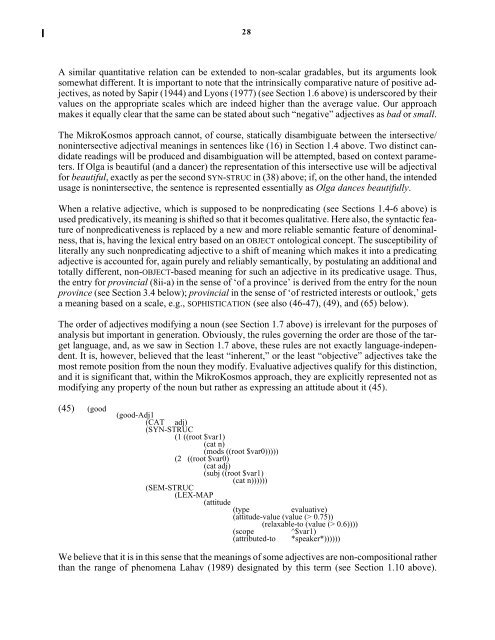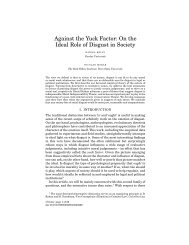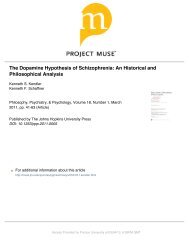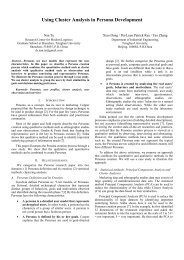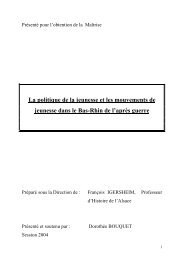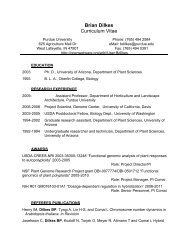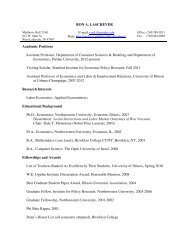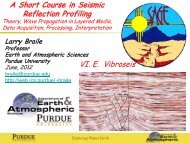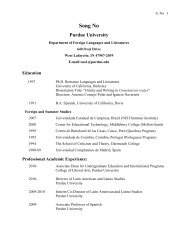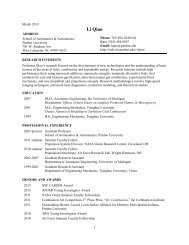Lexical Semantics of Adjectives - CiteSeerX
Lexical Semantics of Adjectives - CiteSeerX
Lexical Semantics of Adjectives - CiteSeerX
Create successful ePaper yourself
Turn your PDF publications into a flip-book with our unique Google optimized e-Paper software.
28<br />
A similar quantitative relation can be extended to non-scalar gradables, but its arguments look<br />
somewhat different. It is important to note that the intrinsically comparative nature <strong>of</strong> positive adjectives,<br />
as noted by Sapir (1944) and Lyons (1977) (see Section 1.6 above) is underscored by their<br />
values on the appropriate scales which are indeed higher than the average value. Our approach<br />
makes it equally clear that the same can be stated about such “negative” adjectives as bad or small.<br />
The MikroKosmos approach cannot, <strong>of</strong> course, statically disambiguate between the intersective/<br />
nonintersective adjectival meanings in sentences like (16) in Section 1.4 above. Two distinct candidate<br />
readings will be produced and disambiguation will be attempted, based on context parameters.<br />
If Olga is beautiful (and a dancer) the representation <strong>of</strong> this intersective use will be adjectival<br />
for beautiful, exactly as per the second SYN-STRUC in (38) above; if, on the other hand, the intended<br />
usage is nonintersective, the sentence is represented essentially as Olga dances beautifully.<br />
When a relative adjective, which is supposed to be nonpredicating (see Sections 1.4-6 above) is<br />
used predicatively, its meaning is shifted so that it becomes qualitative. Here also, the syntactic feature<br />
<strong>of</strong> nonpredicativeness is replaced by a new and more reliable semantic feature <strong>of</strong> denominalness,<br />
that is, having the lexical entry based on an OBJECT ontological concept. The susceptibility <strong>of</strong><br />
literally any such nonpredicating adjective to a shift <strong>of</strong> meaning which makes it into a predicating<br />
adjective is accounted for, again purely and reliably semantically, by postulating an additional and<br />
totally different, non-OBJECT-based meaning for such an adjective in its predicative usage. Thus,<br />
the entry for provincial (8ii-a) in the sense <strong>of</strong> ‘<strong>of</strong> a province’ is derived from the entry for the noun<br />
province (see Section 3.4 below); provincial in the sense <strong>of</strong> ‘<strong>of</strong> restricted interests or outlook,’ gets<br />
a meaning based on a scale, e.g., SOPHISTICATION (see also (46-47), (49), and (65) below).<br />
The order <strong>of</strong> adjectives modifying a noun (see Section 1.7 above) is irrelevant for the purposes <strong>of</strong><br />
analysis but important in generation. Obviously, the rules governing the order are those <strong>of</strong> the target<br />
language, and, as we saw in Section 1.7 above, these rules are not exactly language-independent.<br />
It is, however, believed that the least “inherent,” or the least “objective” adjectives take the<br />
most remote position from the noun they modify. Evaluative adjectives qualify for this distinction,<br />
and it is significant that, within the MikroKosmos approach, they are explicitly represented not as<br />
modifying any property <strong>of</strong> the noun but rather as expressing an attitude about it (45).<br />
(45) (good<br />
(good-Adj1<br />
(CAT adj)<br />
(SYN-STRUC<br />
(1 ((root $var1)<br />
(cat n)<br />
(mods ((root $var0)))))<br />
(2 ((root $var0)<br />
(cat adj)<br />
(subj ((root $var1)<br />
(cat n))))))<br />
(SEM-STRUC<br />
(LEX-MAP<br />
(attitude (type evaluative)<br />
(attitude-value (value (> 0.75))<br />
(relaxable-to (value (> 0.6))))<br />
(scope ^$var1)<br />
(attributed-to *speaker*))))))<br />
We believe that it is in this sense that the meanings <strong>of</strong> some adjectives are non-compositional rather<br />
than the range <strong>of</strong> phenomena Lahav (1989) designated by this term (see Section 1.10 above).


